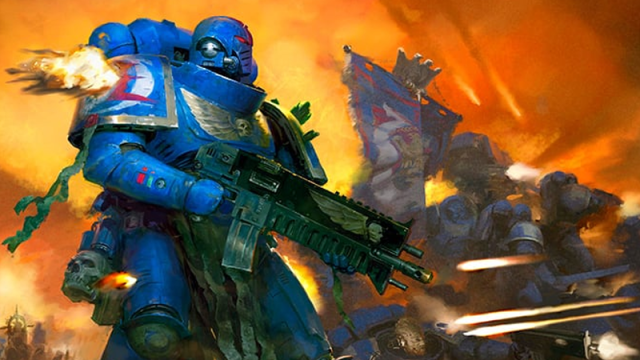Warhammer 40,000 might be one of the biggest and best known wargames around, having made the leap from the tabletop to video games, books, comics, and now, with the help of megafan Henry Cavill, an Amazon streaming franchise of TV shows and movies. But it and its grand, densely written world are still difficult to parse for newcomers who don’t know the right side up of a chainsword.
Admittedly there’s probably no good or particularly safe side of a chainsword, but if you’re curious about the 40K boom now that Amazon has gotten into it — and celebrities like Cavill and Rahul Kohli have taken to evangelizing it — and don’t know where to start, here’s a beginners’ guide to the game and world of what Cavill, Games Workshop, and Amazon are hoping could be one of the next big blockbuster sci-fi franchises.
What *Is* Warhammer 40,000?

Beginning with Warhammer 40,000: Rogue Trader in 1987, 40K — as it’s commonly abbreviated — is a sci-fi tabletop wargame, now in the ninth edition of its ruleset. Players build, paint, and collect armies of various human and alien factions, then pit them against each other in competitive battles, vying to control areas of a board or wipe out their opponent’s forces. Unlike Dungeons & Dragons, which utilises an array of dice for decision-making rolls and combat, everything in Warhammer 40,000 uses standard six-sided dice to determine things like whether your attacks hit and wound an opponent, how far your units can charge into battle, or if one of your heroes can pull off a special action or magical ability.
Warhammer 40,000‘s success has created a vast array of spinoffs developed by its creators, Games Workshop. Set within the same 40K universe there are small-scale skirmish games like Necromunda and Kill Team, and there is an adjacent fantasy setting, Warhammer: Age of Sigmar — the evolution of what was previously known as Warhammer Fantasy Battles — with its own universe and spinoff titles. The series has slowly but surely expanded into a transmedia empire, with Games Workshop releasing its own novels and short fiction, and licensing out the series for comics, video games, and now TV and movies through a new deal with Amazon Studios.
When Is Warhammer 40,000 Set?
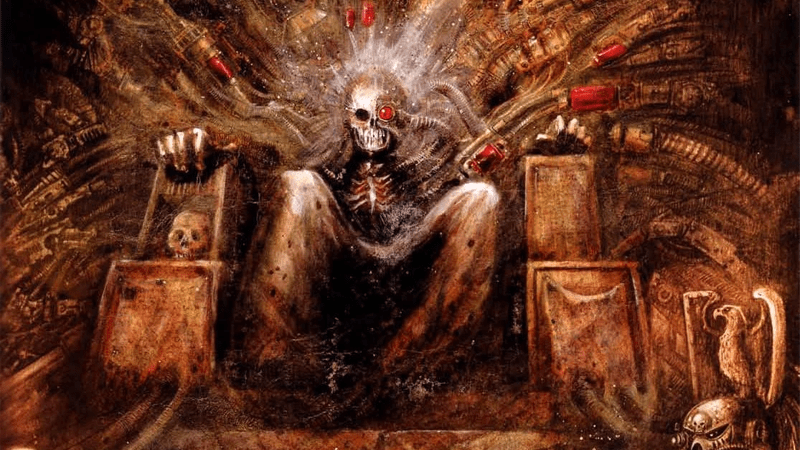
As the name implies, 40K is set in the 41st millennium. A dark future where, as the series’ tagline dutifully tells us, “there is only war,” the game takes place in a galaxy torn apart both metaphorically and physically by mass conflict between the forces of humanity, which has developed into a fanatically religious, xenophobic authoritarian society called the Imperium of Man and colonised thousands of star systems.
They have done so under the guidance of a mysterious, revered leader known only by his title, the God-Emperor, a former formidable warrior and powerful psychic who has lived and guided humankind for thousands and thousands of years. He continues to rule from humanity’s homeworld, Terra, as a decaying, half-dead withered husk plugged into “the Golden Throne,” a vast machine that sustains the Emperor’s life-force through daily sacrifice.
What Is Warhammer 40,000 About?
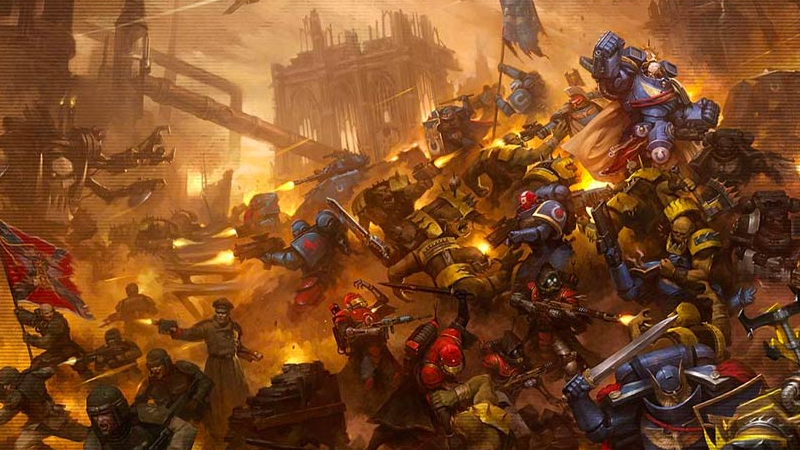
War! Well, that’s the big picture at least. Given that it’s primarily to fuel a physical game about vast armies smashing up against each other, 40K’s setting is primarily to push endless conflict across its galaxy. The Imperium of Man is home to multiple factions fighting in the name of its leader — both zealously rooting out anything that could be perceived as heretical betrayal within humanity’s ranks, and defending its exterior from the major alien races that also vie for control of the universe.
It also extrapolates this conflict to astronomically heighted proportions: everything in 40K is over the top, from giant, hulking, genetically enhanced soldiers in a tank’s worth of body armour, to ridiculous feats of blood-soaked badassery, the Warhammer 40,000 universe is rarely a place for nuance and subtlety. People are dying all the time, everything and everyone is mostly horrifying, and in general, it’s a miserable place to exist. Ever heard of the term “grimdark” in fiction? Well, Warhammer pioneered it in the name of an attempt at satirical commentary, for better or worse.
Who Are the Main Characters of Warhammer 40,000?: The Imperium of Man
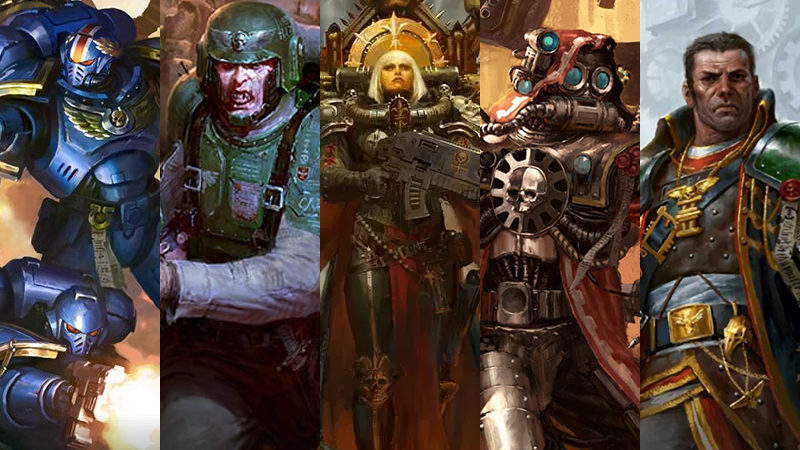
There aren’t really major main characters in 40K. Each faction has important figures and leaders that serve as hero units in the tabletop game and star in its fiction, but the universe is largely about those broader factions rather than the events of particular individual’s lives. You can broadly split the factions of 40K into three groups: the Imperium of Man, the Armies of Chaos, the Imperium’s even darker foil, and the Xenos, the unaligned alien races that also want to wipe out everyone else. There’s a lot to cover here, so let’s kick off with a quick lowdown starting with the forces of humanity:
- The Adeptus Astartes, more commonly known as the Space Marines, are the elite footsoldiers of the Imperium, and the faces of the Warhammer 40K franchise. They are genetically enhanced to be turned into giant, muscle-bound superhumans and clad in gigantic suits of power armour. They’re split into multiple “chapters,” each with their own heraldry and colour schemes, but all untied in service of fighting the alien and purging the heresy perceived by their Emperor. Adjacent to the Astartes are the Adeptus Custodes, the gold-armoured personal bodyguard chapter of the God-Emperor, and Henry Cavill’s army of choice. Don’t be surprised if they appear in the Amazon show he’s starring in.
- The Astra Militarum, or the Imperial Guard, is the Imperium’s rank and file military force made up of regular unenhanced human conscripts and recruits from across its multiple colony worlds. They largely exist to be fed into the grinder of endless war — an Imperial Guardsperson’s career is rarely a long one.
- The Adepta Sororitas, or the Sisters of Battle, are an all-female religious-warrior force, essentially the battle nuns of the Imperium’s faith.
- The Adeptus Mechanicus, the technological and research branch of the Imperium, is home to its giant mechanised war machines, the Imperial Knights, and the cyborg forces of the Tech-Priests and the Skitarii. The Mechanicus believe that a psuedo-heretical alternate deity, the machine god known as the Omnissiah, powers and fuels the Imperium’s weapons technology.
- There’s also the Inquisition, the religious police that roots out corruption from within the Imperium’s borders. It’s broken up into three branches, each targeting a specific kind of heresy: Ordo Malleus, which targets corruption by the forces of Chaos; Ordo Xenos, which targets corruption from alien influences; and Ordo Hereticus, the catch-all branch that roots out disobedience, rebellious elements, and rogue agents that don’t adhere to the strict, brutal doctrines of the Imperial Cult.
Who Are the Main Characters of Warhammer 40,000?: The Armies of Chaos

The Imperium’s primary foe, the Armies of Chaos seek to wipe out the Imperium and the Emperor’s religion in the name of their dark gods.
- The Chaos Space Marines, the corrupted foil of the Space Marines that serve the gods of Chaos rather than the Imperium, broke off from the rest of humanity 10,000 years prior during events known as the Horus Heresy, named for the turncoat former favoured son of the Emperor. Like the Adeptus Astartes, the Chaos Space Marines are split into different legions, each serving one or multiple of the four primary Chaos Gods, known as the ruinous powers: Khorne, the god of war and murder; Nurgle, the god of plague and decay; Slaanesh, the god of pleasure and hedonism; and Tzeentch, the god of change and magic.
- These forces are supplemented by the Chaos Knights, corrupted versions of the Imperium’s own giant war machines, and the Daemons, the hellish servants of the Chaos Gods that exist in the nightmarish psychic sub-dimension known as the Warp alongside their masters.
Who Are the Main Characters of Warhammer 40,000?: The Xenos
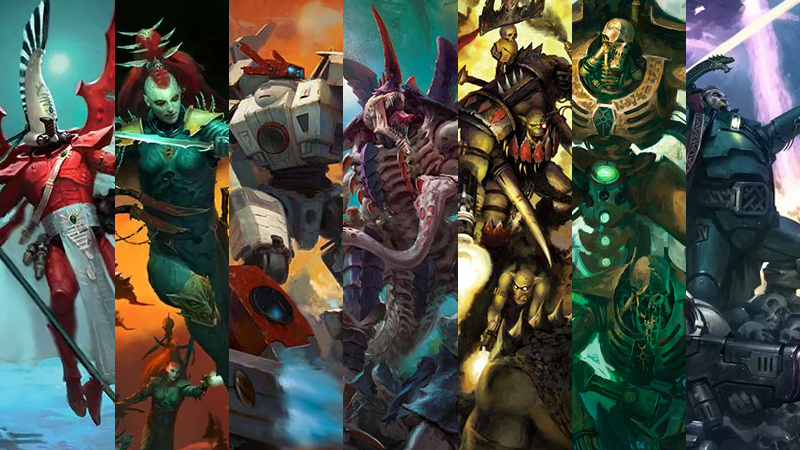
This is… well, everyone else. It’s a big galaxy, and there’s more than just humans in it.
- The Aeldari, also known as the Eldar, are essentially fantasy elves, but sci-fi. Now an all-but-extinguished race, this long-living species ruled most of the galaxy millennia ago with an almighty Empire of its own. Their long lives saw the Eldar pursue everything from martial prowess to creative passions, to the point that their society devolved into depraved hedonism in pursuit of ever-new pleasures — awakening the Chaos god Slaanesh out of the Warp, who feasted on the souls of the Eldar and almost wiped them out entirely. Now, their survivors roam the galaxy on giant world-ships known as Craftworlds, seeking out a home and embittered by their downfall.
- The Drukhari, also known as the Dark Eldar, as also remnants of this empire, but instead of rallying to oppose Chaos, they chose to remain in the decadent ways of their former society, forming cabals of piratical raiders who roam the galaxy enacting pain for their pleasure.
- The T’au Empire is a fairly nascent stellar faction on the fringes of the Imperium’s borders. Ruled by a caste-driven race called the Ethereals, the T’au Empire rigidly believes in a philosophical principle called the Greater Good: a belief that all civilizations must come together to create the greatest benefit to the greatest number of peoples… or be eliminated if they disagree. Flying giant mech suits into battle, the T’au’s forces are made up of both Ethereals and several other species that have joined the Greater Good — including both other Xenos races and human dissidents.
- The Tyranids are an extragalactic, insectoid-esque hive-swarm, intent on hunting and eliminating all other life in the galaxy. Their massive hordes of interconnected bioforms are divided into massive Hive Fleets, each linked psychically through their massive biomechanical ships. The Tyranids are sometimes aided in their invasions of worlds by corrupted sleeper-cells of locals known as Genestealer Cults, who sabotage defences and indoctrinate the populace to become human-alien hybrids, believing they serve an alien god — but largely exist to alert the Tyranids to worlds ripe for consumption, of both cultists and resisters alike.
- The Space Orks are massive, green-skinned warrior-tribes who are the most populous species in the galaxy. Often dismissed as savage, idiotic brutes, the Orks and their forces — driven by a desire for the great “Waaaagh!”, a pseudo-religious crusade to seek out combat and violence — are actually a major threat to the galaxy at large, and the only reason they’ve not dominated it entirely is that often their yearning for conflict sees their myriad factions and tribes turn on each other.
- The Necrons are an ancient machine race that, relatively speaking in the 40K timeline, only just re-emerged on the galactic scene after tens of millions of years in stasis. The former servant forces of the C’tan, the long-extinct oldest intelligent species in the galaxy, the awakened Necrons seek to re-establish their masters’ dominance.
- The Leagues of Votann are the newest faction in 40K, making their debut in the tabletop game earlier this year. A subspecies of humanity termed “Abumans” — genetically divergent descendants of colonists that colonised worlds with radically different gravities and environments to Terra — the leagues are a loosely connected group of mining confederations made up of small, dwarf-esque clones called the Kin. A highly technologically advanced society that co-exists along with artificial mechanical beings known as the Ironkin, the Leagues roam the galaxy mining the resources of the universe, for commercial and technological gain.
How Can I Get Started Playing Warhammer 40,000?
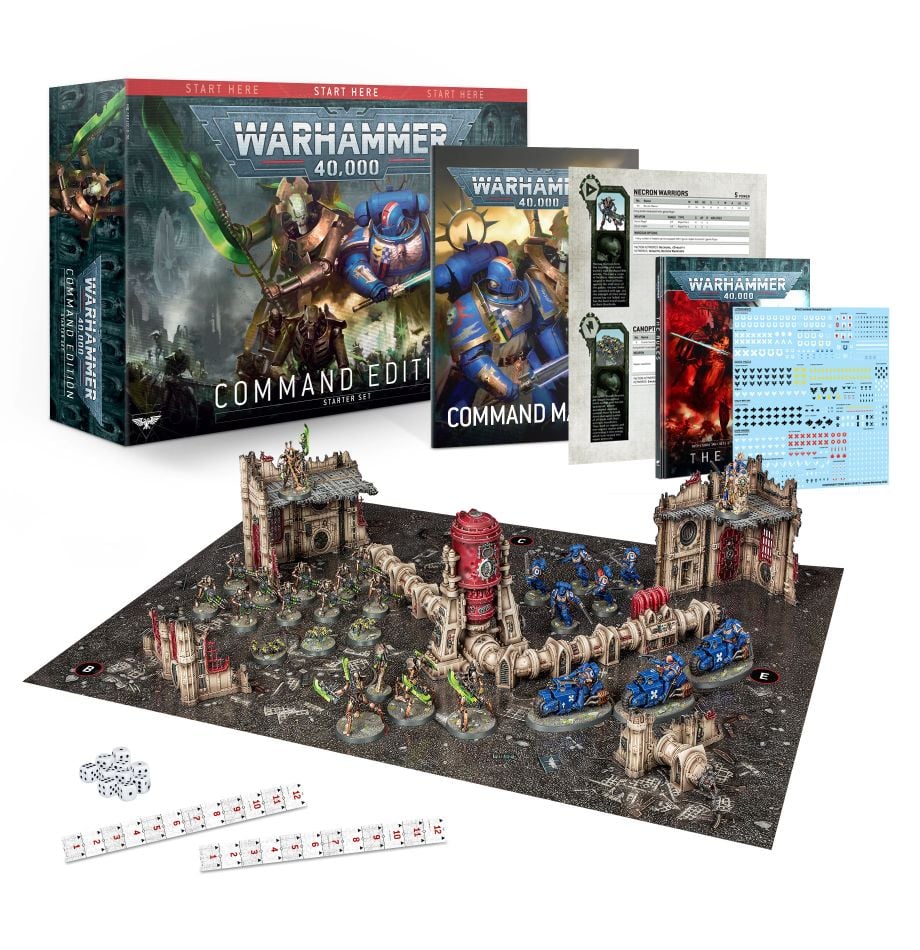
That’s easy enough: buy some Warhammer! Games Workshop’s website — or a store if you live near one — can get you set up with one of the several tiers of Starter sets for 40K, which will come with the miniatures, tools, rulebooks, and scenery to learn and play your first games. From there, you can pick a faction from the ones above you like the sound of, grab their specific set of rules — called a Codex — and some models, and go from there.
The downside of Warhammer in general is that it’s a very expensive hobby to get into — a standard-sized army for any faction can cost hundreds and hundreds of dollars, and that’s not counting the rulebooks or the hobby materials used to put them together and paint them. If you want to get started learning without putting in a significant amount of cash, either grab one of the starter sets, which are relatively cheap in comparison, or you can read the basic core rules of 40K online for free, or through the Warhammer 40K app.
I Don’t Want to Play Warhammer 40,000–Is There Another Way to Learn the Lore?
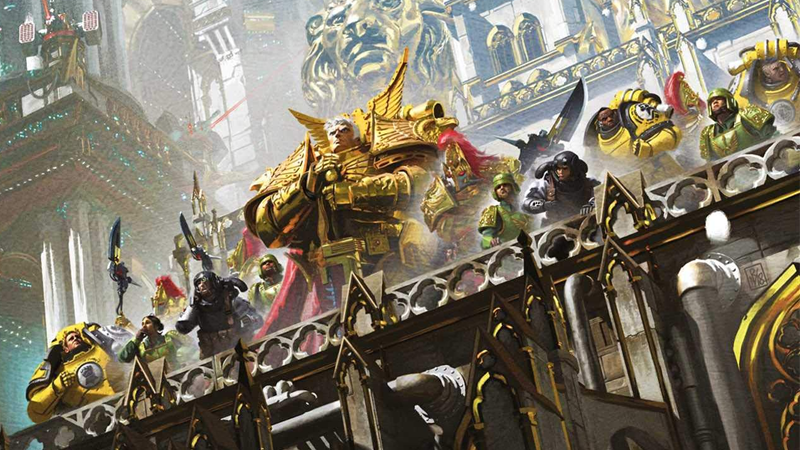
If you don’t actually want to play the game itself and just want to learn about the setting, there are plenty of ways to go about that, too. The aforementioned Codex books for each faction all contain some basic lore and details about the society of their respective factions if you want a wiki-style guide to a particular force you’re intrigued by. There’s also Games Workshop’s Black Library fiction imprint, home to all sorts of books, short fiction anthologies, and audio dramas set in the 40K universe, told from different perspectives within and without the Imperium and other factions. It’s also where you’ll find the epic saga of the Horus Heresy, told across dozens of novels and anthologies to lay out the crucial prequel events of Warhammer 40,000‘s current status quo.
If you’re a video game fan, there’s also plenty of games to try out to give you a taste of the setting — the beloved strategy game series Dawn of War is a good start for the tactically minded, or the recent Chaos Gate: Daemonhunters. If you prefer something a little more action-oriented, there’s the recently-remastered Space Marine, due to get a sequel next year, or the recent co-operative PC shooter Darktide.
